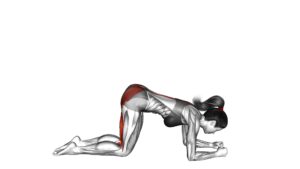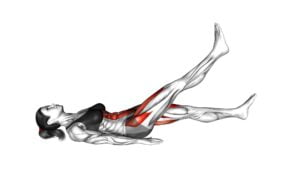Kicks Leg Bent (version 2) – Video Exercise Guide & Tips

Looking to perfect your kicks? Get ready to improve your technique with Kicks Leg Bent (version 2)!
Watch This Exercise Video
In this video exercise guide, you'll discover the benefits, proper technique, and common mistakes to avoid.
Plus, we'll share valuable tips for progressing and a sample workout routine to help you reach your goals.
Don't miss out on this opportunity to level up your kicking skills and take your fitness to new heights!
Key Takeaways
- Greater control and stability during the kick
- Reduced strain on joints
- Increased flexibility
- Improved balance
Benefits of Kicks Leg Bent (version 2)
You can experience several benefits from performing kicks with a bent leg (version 2).
Kicks with a bent leg offer variations and modifications that can be beneficial for your training. One of the main advantages is that it allows for greater control and stability during the kick. By keeping the leg slightly bent, you have a better balance and can adjust your technique more easily if needed.
Another benefit of this variation is that it puts less strain on your joints. The bent leg absorbs some of the impact, reducing the risk of injury. This is especially important if you have any pre-existing joint issues or if you're just starting out with kicks.
Additionally, kicks with a bent leg can help increase your flexibility. By gradually straightening your leg during the kick, you can work on improving your range of motion and stretching the muscles involved. This can contribute to better overall flexibility and enhance your performance in various martial arts disciplines.
In summary, kicks with a bent leg offer benefits such as improved control, reduced strain on joints, and increased flexibility.
Now, let's move on to the next section where we'll discuss the proper technique for kicks with a bent leg (version 2).
Proper Technique for Kicks Leg Bent (version 2)
To execute kicks with a bent leg (version 2), focus on maintaining proper form and balance throughout the movement. This technique requires flexibility and control in order to perform the kick effectively.
Here are some tips to help you improve your technique and flexibility for kicks leg bent (version 2).
Firstly, it's important to warm up your muscles before attempting any kicks. This will help prevent injuries and improve your flexibility. Incorporate dynamic stretches and movements that target the muscles used in the kick, such as the hamstrings and hip flexors.
To achieve proper form, start by standing with your feet shoulder-width apart. Lift one leg and bend it at the knee, keeping your core engaged for balance. As you kick, focus on extending your leg while maintaining control and stability. Keep your upper body straight and avoid leaning or twisting excessively.
Modifications can be made depending on your level of flexibility. If you find it challenging to execute the kick with a fully bent leg, you can gradually work on increasing your range of motion over time. Stretching exercises like hamstring stretches and hip openers can help improve your flexibility for kicks leg bent (version 2).
Remember to practice regularly and gradually increase the intensity of your kicks. With time and dedication, you'll be able to execute kicks with a bent leg (version 2) with proper technique and fluidity.
Common Mistakes to Avoid in Kicks Leg Bent (version 2)
When performing kicks leg bent (version 2), it's crucial to be aware of common mistakes that can hinder your technique and effectiveness. One common mistake isn't maintaining proper form throughout the movement. It's important to keep your core engaged and your back straight to ensure stability and prevent strain on the lower back.
Another mistake to avoid is rushing through the exercise. Take your time and focus on controlled, deliberate movements to maximize the benefits of the exercise. Additionally, be cautious not to overextend your leg. While it's important to have a good range of motion, forcing your leg to go higher than what's comfortable can lead to injury.
Modifications and variations can also contribute to mistakes in kicks leg bent (version 2). It's important to choose a modification or variation that suits your fitness level and abilities. Pushing yourself too hard or attempting advanced variations without proper preparation can lead to poor form and potential injury. Remember to listen to your body and adjust accordingly.
Tips for Progressing in Kicks Leg Bent (version 2)
To progress in Kicks Leg Bent (version 2), focus on gradually increasing the height and speed of your kicks while maintaining proper form and control. Here are some progression tips and advanced variations to help you take your kicks to the next level:
- Gradually increase height: Start by kicking at a comfortable height and gradually work your way up. This won't only improve your flexibility but also enhance the power and effectiveness of your kicks.
- Increase speed: Once you have mastered the proper technique, try to increase the speed of your kicks. This will improve your overall kicking speed and make your movements more explosive.
- Incorporate advanced variations: Once you feel confident with the basic kicks leg bent (version 2) exercise, you can challenge yourself by incorporating advanced variations. This could include adding a jump before the kick or combining multiple kicks in a sequence.
By following these progression tips and exploring advanced variations, you can continuously challenge yourself and improve your performance in Kicks Leg Bent (version 2).
Now, let's move on to the next section and explore a sample kicks leg bent (version 2) workout routine.
Sample Kicks Leg Bent (version 2) Workout Routine
Now let's dive into a sample workout routine for Kicks Leg Bent (version 2) that will help you further enhance your kicks and improve your overall performance.
When performing kicks leg bent (version 2), it's important to consider modifications based on your fitness level and flexibility.
Start with a proper warm-up that includes dynamic stretches and mobility exercises to prepare your body for the workout.
Begin by practicing the basic kicks leg bent (version 2) technique, focusing on proper form and control. Gradually increase the intensity and duration of each set as you progress.
Incorporate exercises that target the muscles used in kicks leg bent (version 2), such as squats, lunges, and leg lifts.
Additionally, flexibility plays a crucial role in executing kicks leg bent (version 2) effectively. Include static stretching exercises for your hips, hamstrings, and quadriceps to improve your range of motion.
Remember to cool down and stretch after your workout to prevent muscle soreness and promote recovery.
Frequently Asked Questions
Can I Perform Kicks Leg Bent (Version 2) if I Have a Knee Injury?
If you have a knee injury, it's important to modify exercises to avoid further damage. Kicks Leg Bent (version 2) may not be suitable for you in this case.
However, there are alternatives that can be performed to target similar muscle groups without putting strain on your knees.
It's recommended to consult with a medical professional or a qualified fitness trainer to determine the best modifications or exercises that are safe for your knee injury.
How Many Calories Can I Burn by Doing Kicks Leg Bent (Version 2)?
To determine the number of calories burned from doing Kicks Leg Bent (version 2), it's important to consider factors such as your weight, intensity, and duration of the exercise.
This exercise primarily targets the glutes and hamstrings, which can help increase calorie burn.
However, it's essential to consult with a healthcare professional for knee injury modifications to ensure proper form and avoid exacerbating your condition.
Can Kicks Leg Bent (Version 2) Help Improve My Balance and Stability?
Kicks Leg Bent (version 2) can indeed help improve your balance and stability.
By incorporating this exercise into your routine, you'll be engaging and strengthening your leg muscles, which are crucial for maintaining a stable base.
Additionally, the controlled movements involved in this exercise can enhance your overall balance.
Are There Any Modifications or Variations of Kicks Leg Bent (Version 2) for Beginners?
There are modifications and variations available for beginners to try with kicks leg bent (version 2). These modifications can help you gradually build up your strength and stability.
By starting with simpler variations and gradually increasing the intensity, you can safely improve your balance and stability over time.
It's important to listen to your body and not push yourself too hard, especially if you're just starting out.
How Often Should I Incorporate Kicks Leg Bent (Version 2) Into My Workout Routine for Optimal Results?
To optimize results, incorporate kicks leg bent (version 2) into your workout routine. This exercise is great for a HIIT workout, as it targets your lower body strength. By adding kicks leg bent, you'll engage your glutes, hamstrings, and quads, while also improving your balance and coordination.
Aim to include this move 2-3 times a week for best results. Remember to warm up properly and listen to your body to avoid injury.
Conclusion
In conclusion, kicks leg bent (version 2) is a beneficial exercise that targets the leg muscles and improves flexibility and balance.
By following the proper technique and avoiding common mistakes, you can maximize the effectiveness of this exercise.
To progress in kicks leg bent, gradually increase the number of repetitions or add resistance.
Incorporating kicks leg bent into your workout routine can help you achieve stronger and more toned legs.

Author
Years ago, the spark of my life’s passion ignited in my mind the moment I stepped into the local gym for the first time. The inaugural bead of perspiration, the initial endeavor, the very first surge of endorphins, and a sense of pride that washed over me post-workout marked the beginning of my deep-seated interest in strength sports, fitness, and sports nutrition. This very curiosity blossomed rapidly into a profound fascination, propelling me to earn a Master’s degree in Physical Education from the Academy of Physical Education in Krakow, followed by a Sports Manager diploma from the Jagiellonian University. My journey of growth led me to gain more specialized qualifications, such as being a certified personal trainer with a focus on sports dietetics, a lifeguard, and an instructor for wellness and corrective gymnastics. Theoretical knowledge paired seamlessly with practical experience, reinforcing my belief that the transformation of individuals under my guidance was also a reflection of my personal growth. This belief holds true even today. Each day, I strive to push the boundaries and explore new realms. These realms gently elevate me to greater heights. The unique combination of passion for my field and the continuous quest for growth fuels my drive to break new ground.







